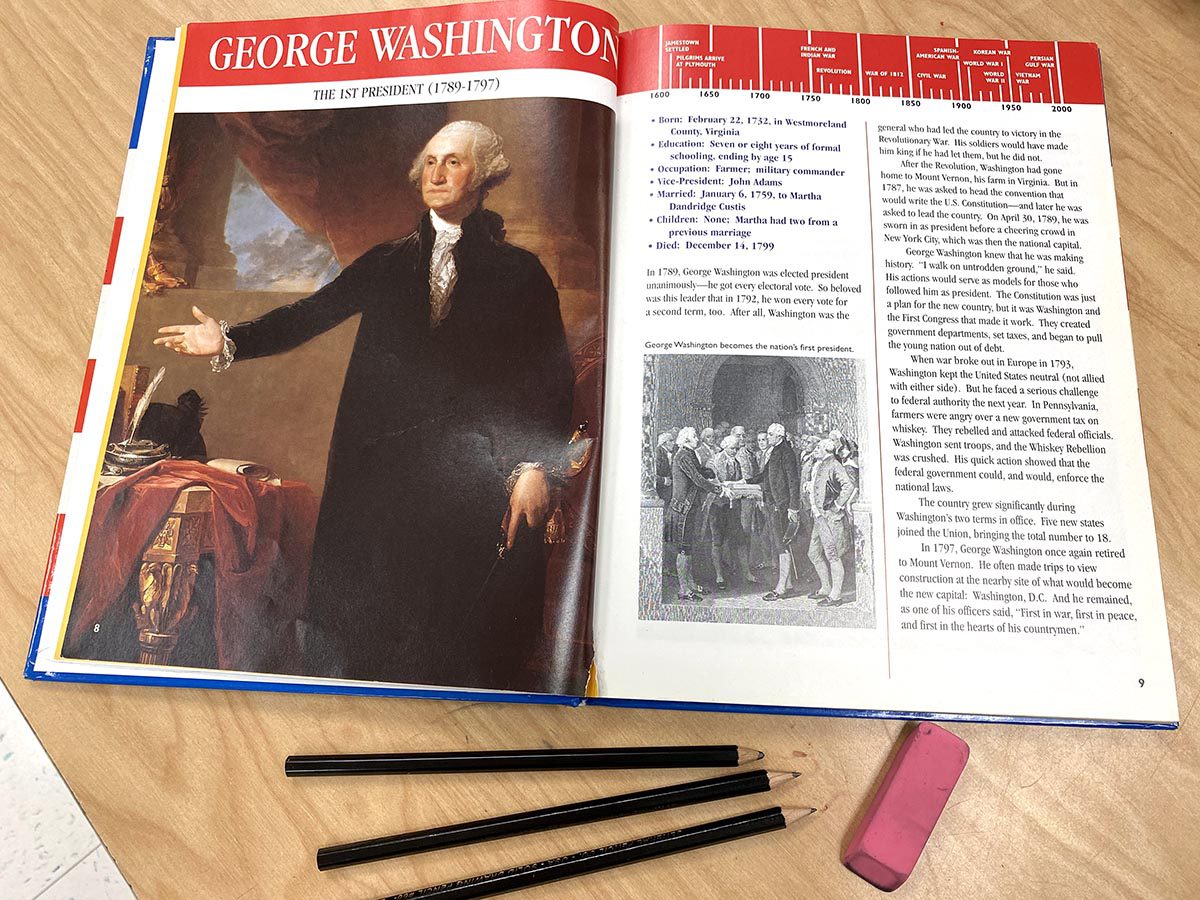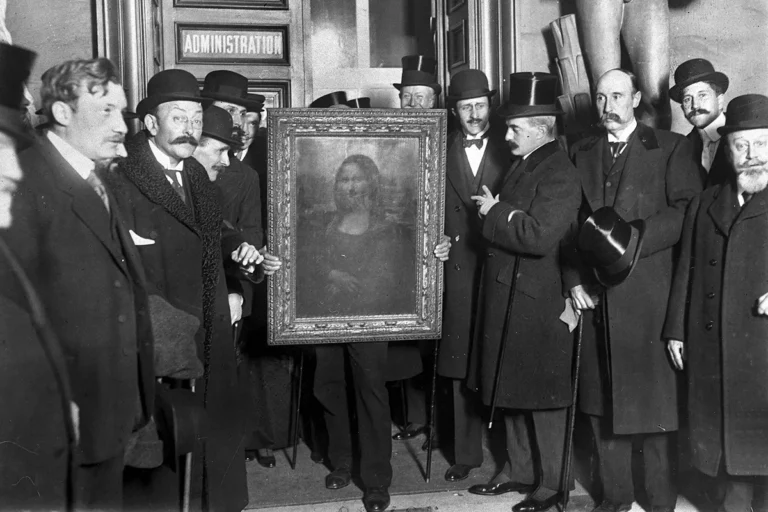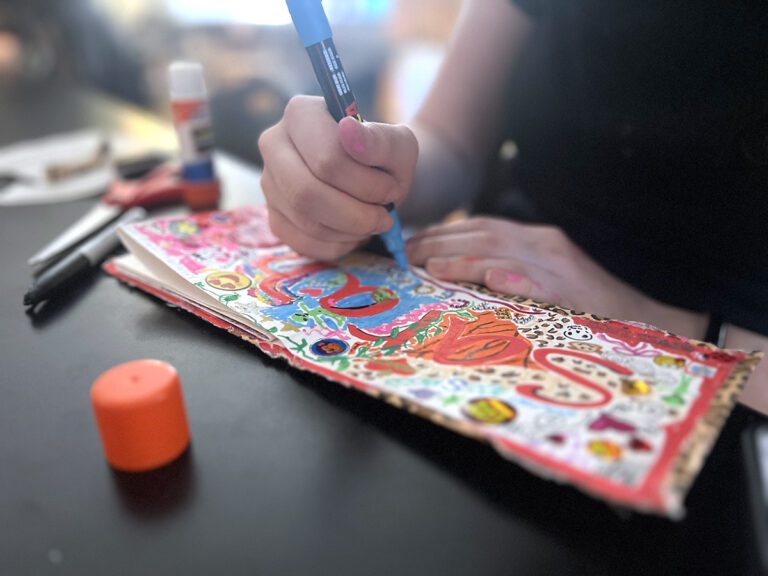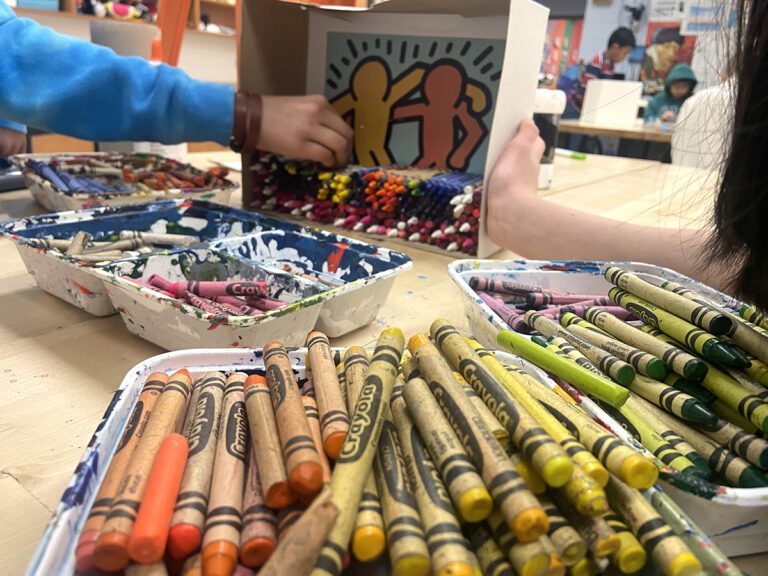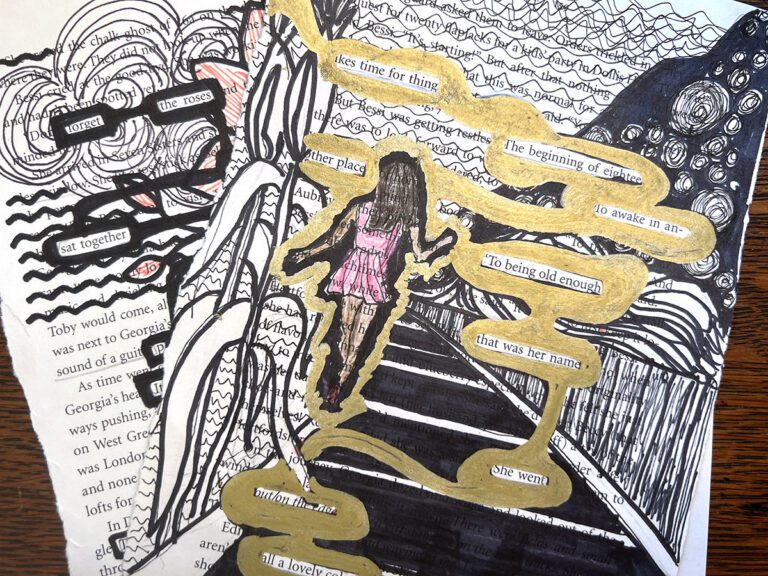Brush up on your history, because today we’re preparing for a presidential portrait party! Art education plays a pivotal role in connecting students with history. It offers them a unique lens through which to explore and understand the past. As we celebrate President’s Day, a day dedicated to honoring the leaders who have shaped the course of American history, it is an opportune moment to reflect upon the impact of their presidential portraits. These special portraits give us a glimpse into the time’s cultural, political, and artistic trends. In this article, we’ll uncover the rich historical value of presidential portraits through hands-on art activities. Use these portraits as engaging learning tools in the classroom to bring history to life!
Presidential Portraits: History and Context
Exploring the evolution of presidential portraiture is a fascinating journey through American art history. Historically, presidential portraits represented power. It was expensive and time-consuming to get a portrait painted. Plus, portraits were the only way to capture what the individual looked like before cameras. Many portraits also incorporate symbols such as specific architecture, poses, and items to convey strength and leadership. Initially, most presidential portraits were in the classical European style. However, variations from this tradition soon emerged. Portraits like Theodore Roosevelt by John Singer Sargent, John F. Kennedy by Elaine de Kooning, and Bill Clinton by Chuck Close are notable examples of this evolution.
Find out how to integrate presidential portraits into your classroom with the 10 ideas below.
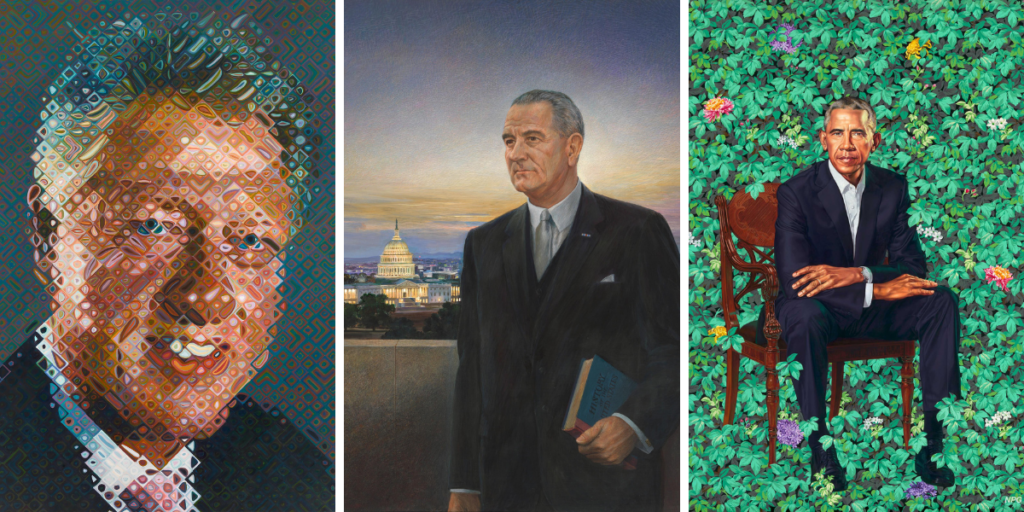
Write about presidential portraits.
Presidential portraits in your curriculum offer a rich tapestry of opportunities to engage students in written exploration. Let’s see how these portraits inspire writing exercises that connect to multiple subject areas.
Here are two strong cross-curricular connections:
- English and Language Arts
Students compose a dating or social media profile to capture the president’s character traits and interests based on what they observe in the portrait. This exercise encourages storytelling and a deeper curiosity of the subject’s character. - Social Studies
Students analyze a portrait during class and research background information. Focus the investigation on the era so students can connect the dots between art and history. Collaborate with your social studies department to see what time periods and major historical events they cover to narrow down the portraits from which your students select.
Use presidential portraits as primary sources.
Every brushstroke in a presidential portrait is a deliberate choice. Beyond aesthetics, presidential portraits are valuable primary sources. They reveal presidents’ physical appearance and cultural values. Encourage your students to treat these portraits as historical documents and delve into the nuances of clothing, accessories, and symbols present in the artwork.
Here are three activities to guide your students:
- Craft an artist statement to explore motivations.
Students research the president and the corresponding artist. Explore historical context, achievements or challenges during their term, and the artist’s background and style. Students imagine themselves as the artist and write a brief artistic rationale explaining their creative choices. What message do they want to convey? How do they want to project the president’s image to the public? This exercise promotes critical thinking about the politics of image-making and its relevance in modern media. - Search for symbols of power to draw deeper conclusions.
Select a prominent presidential portrait rich in symbols of power. Organize a visual scavenger hunt where students locate a list of symbols and elements in the portrait, such as flags, columns, and specific items of attire. Facilitate a discussion about the significance of these symbols and encourage students to speculate about the artist’s message. - Depict a person of authority to brainstorm original symbols.
Students create their own symbolic portrait illustrating a current leader or figure of authority. It can be a teacher, principal, parent—or even them as a future president! Select symbols to convey power and authority specific to the person and their role and responsibilities. This activity promotes reflection about what they value in a leader.
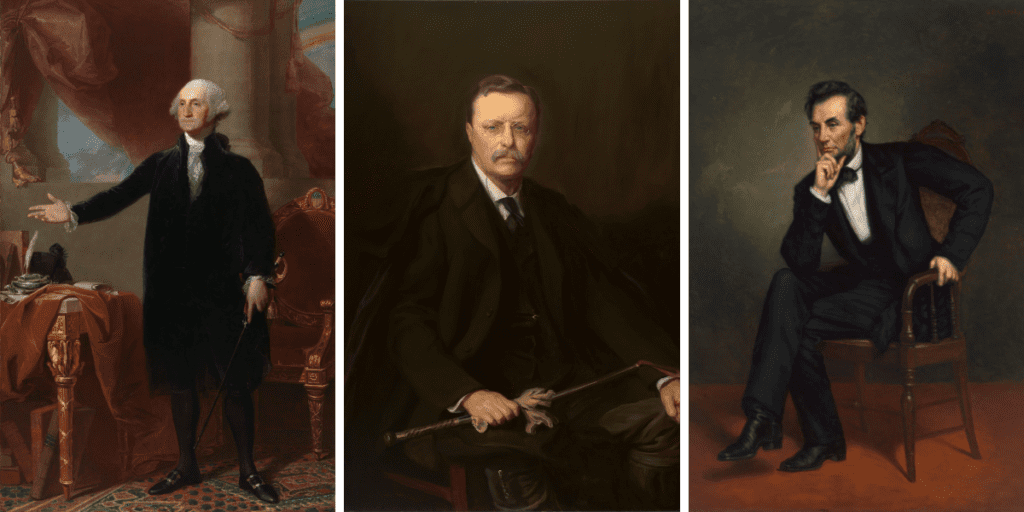
Teach proportion through portraiture.
One of the most compelling aspects of presidential portraiture is the opportunity they present for teaching proportions—a fundamental skill we often struggle to teach. This skill not only enhances students’ ability to create realistic portraits of their own but it also sharpens their observational skills and deepens their understanding of the human figure.
Here are two simple ways to bring proportion into your lesson:
- Trace the essentials to identify clear placement.
Assign each student a presidential portrait. Provide them with tracing paper, a layer in Photoshop, or a piece of acetate. Students overlay their chosen medium on top of the portrait and draw proportion lines, marking key points like the eyes, nose, mouth, and ears. This exercise helps students see and understand the precise placement of facial features. - Time students for a fun gesture challenge.
Provide portraits that show more of the president’s body and pose. Set a timer for your students to create quick gesture drawings. We can’t afford professional models for our drawing classes, but we have a great collection of presidential portraits! They’re perfect for practicing figure drawing with any age group.
Compare and contrast portraits.
Comparing and contrasting presidential portraits exposes students to the diverse styles and techniques of famous artists. Provide students with a selection of presidential portraits from different eras. Encourage them to conduct a visual analysis where they identify key similarities and differences in style, technique, and subject portrayal.
Here are three out-of-the-box ways students can compare and contrast:
- Design an artist trading card to introduce students to famous portrait artists.
Assign each student a famous portrait artist to create an artist trading card. The front will be their rendition of the portrait. The back will feature key information including a brief biography and snippet about the artist’s signature style. Students present their cards to their peers and share stories about the artist. Allow students to trade cards with classmates after the presentations. - Participate in a fast-paced “Speed Dating” game to learn fun facts.
This game is perfect for older students! Students research the artists and record their findings. Add in your own fun facts, like how George W. Bush went on to exhibit his own portrait paintings after his presidency. Rearrange the classroom into several stations with each artist’s information at a station. Students rotate through the stations in small groups to get to know each artist. They will jot down their thoughts on “artist journal cards.” Once students have made it through all of the stations, discuss which artists stood out as the “best date!” - Recreate a portrait with a modern twist to make relevant connections.
In an advanced course, students select a presidential portrait and analyze its artistic techniques. Students hone in on the medium, color palette, lighting, and style. Students recreate the portrait in a more modern art style. They also will consider how the president would look if they were alive today and update the clothes, hairstyle, and background. Introduce new portrait artists like Jonathan Mcafee or Oliver Winconek to provide stylistic inspiration.
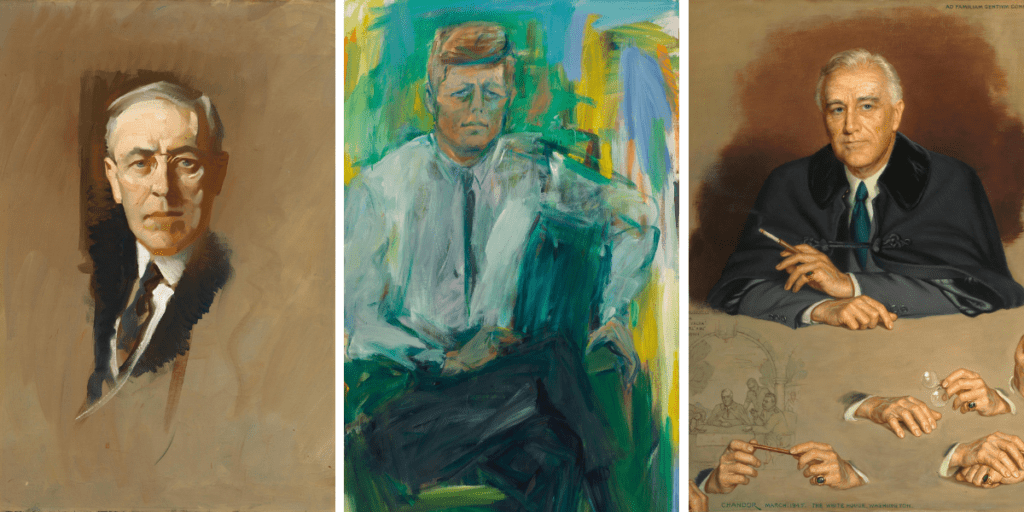
Jumpstart your next portrait lesson with resources!
There is a wealth of resources to make incorporating presidential portraits into your art room a breeze. Talk with your school’s library or media center specialist to see what books are already on campus for your students to use. Reach out to your local historical society to see if they have resources about your county. Speak to your social studies department about collaborating on cross-curricular lessons.
Check out the links below for more information and tips:
- National Portrait Gallery- Presidential Portraits
- America’s Presidents Exhibition
- The White House Historical Association: The Presidents Biographies and Portraits
- Engaging Students with Art History (Ep. 356)
- Portraits and Pencils Collection in FLEX Curriculum
- Experimenting with Portraiture Collection in FLEX Curriculum
- Portraiture at Secondary Level Pack in PRO Learning
The fusion of presidential portraits and art education is a remarkable connection that can fill our classrooms with curiosity, critical thinking, and a deeper tie to history. By delving into the artistry, narratives, and symbolism behind these portraits, students refine their artistic skills and gain a profound appreciation for the power of visual storytelling. As art teachers, we have the privilege of guiding our students on this inspiring exploration, where brushes and canvases become windows into the past. We have the opportunity to show how artistic techniques to render a likeness meld with history, politics, and communication. Let’s continue to paint a brighter future for the next generation of artists, historians, and critical thinkers by exploring presidential portraits of the past.
How will you incorporate presidential portraits into your curriculum?
What is your favorite presidential portrait and why?
Magazine articles and podcasts are opinions of professional education contributors and do not necessarily represent the position of the Art of Education University (AOEU) or its academic offerings. Contributors use terms in the way they are most often talked about in the scope of their educational experiences.
